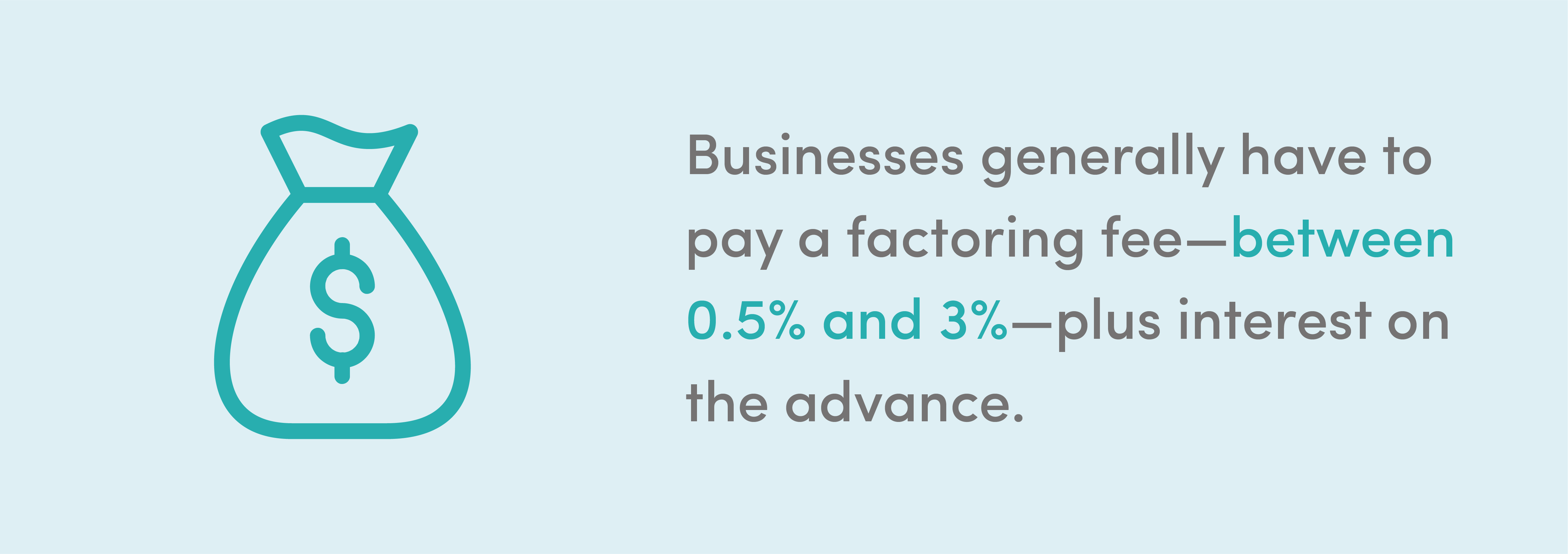Written by: Jacob Dayan
Operating your business on an accrual basis has many benefits, but one notorious drawback is that outstanding accounts receivable can take some time to settle. However, there is a workaround for this; whether small business owners find their businesses in dire need of an immediate cash injection or simply want to expedite income from slow payers, accounts receivable factoring can do the trick. This article examines account receivables factoring, how it works, and whether it is the right call for your business.
Put simply, accounts receivable factoring entails selling your outstanding receivables to a third party— known as a factoring company or factor— typically for a set percentage of the outstanding amount. This percentage varies (more on that later on) but it can be as high as 97% of the original value of the receivables. After purchasing your receivables, the factoring company is entitled to the outstanding amount once it’s paid.
Accounts receivable factoring is popular among business owners because it serves as a debt-free alternative to loans as a means to obtaining owed income in advance. There is no interest, no fees, and little hassle — factoring is finalized at the point of sale.

Factoring companies charge a “factoring fee.” — a percentage of the total value of the sold receivables. As mentioned previously, this percentage can fluctuate based on five various factors: industry, amount, quality, time, and type.
The accounts receivable factoring rate often varies from industry to industry. For example, a factoring company will offer a different rate to a construction company compared to the rate provided to a retail company.
Some factoring companies offer better rates for high-value or high-volume receivables.
Quality includes the punctuality and creditworthiness of a business’s customers. Factoring companies will offer ideal rates for receivables with high-quality payers — no factoring company wants to find themselves stuck with non-payers.
When looking at potential receivables, factoring companies will consider the average days outstanding to determine how quickly the items will be paid.
Finally, factoring companies will offer different rates whether using recourse factoring or non-recourse factoring.
There are two types of accounts receivable factoring: with and without recourse. The type depends on which party accepts the risk: the selling company or the factoring company. With recourse factoring, the factoring company can demand a refund from the selling company in the event that it cannot collect from customers. However, with non-recourse factoring, the factoring company takes on all the risk of uncollectible receivables; the selling company has no liability for uncollectible receivables.
Typically, factoring companies will charge a lower rate for recourse factoring than for non-recourse factoring. When using non-recourse factoring, the factoring company charges a higher rate to better compensate for the risk. However, with recourse factoring, the selling company is liable for the receivables if they aren’t paid. This can be problematic if your business has a shortage of consistent, quick-paying customers.
To show non-recourse factoring in action, let’s take a look at a hypothetical small business: a B2B supplier called The Money Store, LLC. Stefan, the owner of The Money Store, needs to cover a pressing liability worth $200,000 but doesn’t have the cash on hand to do so. However, The Money Store’s current accounts receivable are worth $500,000 — more than enough to cover this liability. Stefan subsequently decides to factor his accounts receivable on a non-recourse basis. Because non-recourse factoring shifts the risk to the factoring company, Stefan must pay a premium rate — he only receives $400,000 from $500,000 worth of receivables. Nevertheless, Stefan can now settle his liability with cash to spare.
Let’s say Stefan has a perennial problem client, Zach. Half the time, Zach takes months to fulfill his invoices; half the time, he doesn’t pay them at all. However, because Stefan factored his receivables on a non-recourse basis, Zach is no longer his problem; the factoring company must assume all the risk. This risk has been somewhat mitigated by the premium rate Stefan had to pay, but the factoring company is still on the hook for Zach.
If Stefan factors his receivables on a recourse basis, he gets a better initial rate — let’s say $450,000, with a $50,000 hold back — for the same $500,000 worth of receivables. After buying the receivables, the factoring company collects $490,000; Zach accounts for the $10,000 not collectible. In this case, Zach’s outstanding amount is Stefan’s responsibility as this amount is deducted from the holdback before the factoring company remits it to Stefan.
It is essential to exercise caution when factoring on a recourse basis; although one inconsistent customer won’t pose a huge problem, a high volume of nonpayers can quickly turn your accounts into a bottomless pit.
The advance rate is the percentage of an invoice the factoring company pays upfront. Once the invoice is fulfilled, the factoring company remits the remaining value back to the selling business. Typically, this comes in the form of a factoring rebate. The reason for the advance rate is to protect the factoring company from risk. If a high enough percentage of the receivables aren’t fulfilled, the factoring company will not issue a factoring rebate and instead use the money to cover any losses.
The factoring fee refers to the fee a factoring company charges when providing a factoring service. Typically, this is applied as a percentage of the value of the receivables. For example, a factoring company may charge 5% for an invoice due in 45 days. However, factoring companies may charge on a weekly or monthly basis instead.
Not all factoring companies hold reserve accounts, but many do. Much like with advance rates, where a portion of the receivables’ value is held to mitigate risk, many factoring companies maintain a reserve account to reduce risk further. Reserve accounts typically contain 10–15% of the selling company’s credit line.

Spot factoring is becoming more and more prevalent. Traditionally, factoring companies would tie selling companies down in long-term contracts. However, spot factoring allows a company to factor a single invoice. This has made accounts receivable factoring easy to access for small businesses. However, the lack of predictable volume means that spot factoring will typically incur a cost premium to make up for the lack of long-term contracts and minimums.
A growing number of small businesses utilize accounts receivable factoring to stabilize and accelerate cash flow. Factoring your business’s accounts receivable can provide steady, predictable capital, facilitate expansion, and optimize the payables cycle, enabling discount pricing for early vendor payments.
There are five primary advantages to utilizing accounts receivable factoring:
When a factoring company takes on receivables, it notifies the selling business’s customers. This is because your customers are no longer paying you — they are paying the factoring company. If your customers receive notice that you sold your accounts receivable without hearing it from you first, they may see this as a sign of financial weakness. While accounts receivable factoring is not a sign of financial weakness, it may be misperceived as one.
Once you hire a factoring company, your business will be able to utilize the factoring company’s internal credit department to qualify your customers. For example, the factoring company may affect your ability to do business with customers with questionable credit histories or ratings. Typically, the factoring company would render these receivables ineligible, so they cannot be advanced against. However, it is ultimately up to you as a business owner to make an informed decision to continue working with that customer.
In addition, while accelerating your receivables has significant inherent benefits, there is a cost. Typically, this cost includes the factoring fee — between 0.5% and 3% — plus interest on the advance. As you factor your receivables, be sure to constantly measure your return on investment based on several factors: expansion, better buying power, enhanced product offering, stabilize working capital, and more. Assess these against the factoring expense.

Related Reading: How to Reconcile a Bank Statement
Factoring’s origins lie in early international trade. Various sources date the origin of accounts receivable factoring back to the Code of Hammurabi.
Like all financial concepts, factoring has evolved over the centuries. Factoring owes its evolution chiefly to changes in the prevailing business organization, technology, and modifications to the common law framework in the Western World.
In the twentieth-century United States, factoring became the pre-eminent method of accruing capital for growth, especially within the textiles sector. This occurred in part due to the United States banking system’s structure, filled with a plethora of small banks with limitations on advance amounts.
At the start of the 21st century, policymakers recognized the rationale for maintaining factoring as a financial instrument; factoring is ideal for the growing demands of innovative, rapidly growing businesses.
It’s easy to think of accounting and bookkeeping as necessary evils to keep the IRS off your back. But a highly competent financial team can provide essential business insights, find crucial tax savings, and allow business owners to spend less time stressing the financials and more time serving customers. Sign up to get a custom quote today for FinancePal’s professional financial services.

Jacob Dayan is a true Chicagoan, born and raised in the Windy City. After starting his career as a financial analyst in New York City, Jacob returned to Chicago and co-founded FinancePal in 2015. He graduated Magna Cum Laude from Mitchell Hamline School of Law, and is a licensed attorney in Illinois.
Jacob has crafted articles covering a variety of tax and finance topics, including resolution strategy, financial planning, and more. He has been featured in an array of publications, including Accounting Web, Yahoo, and Business2Community.

Nick Charveron is a licensed tax practitioner, Co-Founder & Partner of Community Tax, LLC. His Enrolled Agent designation is the highest tax credential offered by the U.S Department of Treasury, providing unrestricted practice rights before the IRS.
Read More
Jason Gabbard is a lawyer and the founder of JUSTLAW.

Andrew is an experienced CPA and has extensive executive leadership experience.
¿Por qué son importantes las 5 C del crédito y cómo dominarlas?
Diferencias entre la contabilidad y el manejo de libros contables
Discussed options for my business with Brian and he was very helpful in suggesting how best to handle it.
Contact us today to learn more about your free trial!
By entering your phone number and clicking the "Get Custom Quote" button, you provide your electronic signature and consent for FinancePal to contact you with information and offers at the phone number provided using an automated system, pre-recorded messages, and/or text messages. Consent is not required as a condition of purchase. Message and data rates may apply.
By entering your phone number and clicking the “Get Started” button, you provide your electronic signature and consent for FinancePal to contact you with information and offers at the phone number provided using an automated system, pre-recorded messages, and/or text messages. Consent is not required as a condition of purchase. Message and data rates may apply.
